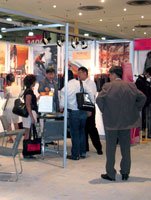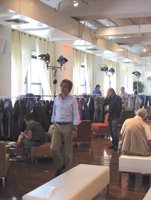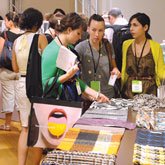Surprising Turnout for N.Y. Textile Shows
NEW YORK—Roving packs of designers and buyers traversed New York during the city’s de facto Textile Week, browsing the international offerings at Texworld USA, Premiegrave;re Vision Preview New York and the Prefab: Supima Premium Fabric Show. Those in the premium-jeans business made an extra stop at denim show Kingpins.
The companies shopping the shows were primarily East Coast brands, including Marc by Marc Jacobs, Theory, DKNY, Calvin Klein, Chico’s, Victoria’s Secret and Badgley Mischka, according to show organizers. Some large international names turned out, notably Marks & Spenser and Next. And a few West Coast companies made the trip as well, including Guess, BCBG Max Azria, Laundry, John Paul Richard, Bebe and Old Navy.
Local buyers and those who came into town early had a chance to stop by “You Can Find It Here!,” a panel discussion with domestic suppliers of textiles, fibers, trim and yarn. Organized by AboutSources.com, the panel included representatives from Lenzing Fibers, FesslerUSA, Brittania Mills, Wellman Inc., Natural Fiber Mills and Beyond the Loom.
Global and eco at Texworld
The largest show of the week was Texworld, organized by Messe Frankfurt, which featured 180 companies from 16 countries, including China, South Korea and Turkey. Running July 14–16 at the Jacob K. Javits Convention Center, the show included a few exhibitors with headquarters—or roots—in Europe, including Germany-based Hemmers-Itex and France-based Les Tissus Marey. Exhibitor Jiangsul Girmes Special Textile Co. Ltd.—better known as GSTZ—is a vertical textile mill based in Zhangjiagang City, China. The company was originally founded by then-partners J.L. de Ball Canada and German textile maker Girmes GmbH.
Les Tissus Marey designs its prints collections in Paris and produces them in China. “It’s out of China, but it has all the standards of a European mill,” said New York representative Gera Gallico. The company has two lines, a higher-end silk collection and a more-moderately priced synthetic line with higher minimums. Marey’s Paris-based export area manager, Anne Marie Nys-Acker, said the company made the shift to China five years ago.
This was the second time at the show for San Gabriel, Calif.–based Met Textiles USA Inc. The company—which produces printed velvet and velveteen, as well as full-package garments, from its facility in Shanghai—has also exhibited twice at Texworld in Paris. General Manager Mordy Guan said he was seeing primarily East Coast buyers from New York and Pennsylvania at the show.
This was the first time at Texworld for Fran Sude, founder of Los Angeles–based color- and trend-forecasting company Design Options. Sude, who hosted a trend seminar at the show, said she was impressed with the caliber of the attendees. “I found some huge people who came out of their offices to look for what’s next in textiles,” she said.
This was the fifth edition of the U.S. show, which is produced by German trade-show giant Messe Frankfurt. This season, the number of exhibitors dipped slightly from last July, when the show featured 194 companies, according to Stephanie Everett, Messe Frankfurt USA’s group show manager, textile shows. Everett said this season’s show drew a mix of attendees that ranged from new businesses to international mega-brands.
“We have seen anyone from start-up companies doing apparel for pets to Wal-Mart, Target and Macy’s,” she said. “We’ve seen the whole gamut.”
The unaudited visitor number was 2,842, according to Everett, who said that figure represented a 13 percent increase over last July.
Once again, fiber maker Lenzing sponsored the show, and for this edition, the Austria-based maker of Tencel, Modal and Viscose opted for an eco theme to highlight its products’ environmentally friendly characteristics. The Lenzing Botanic Symposium featured several eco-themed seminars, including an overview of the LOHAS (“Lifestyles of Health and Sustainability”) customer; a discussion of ecologically friendly, sustainable and recycled fabrics; and the results of a recent fiber lifecycle–analysis study conducted by the Netherlands-based University of Utrecht.
Several speakers discussed Tencel’s eco roots. “Lyocell [Tencel’s generic name] was made to be an environmental replacement for Viscose,” said Michael Kininmonth, Lenzing’s project manager apparel, business development and innovation, textile fiber.
Lyocell gets its cellulosic base from wood pulp, primarily eucalyptus trees. According to Kininmonth, the trees used to make Tencel are grown on marginal land without the use of pesticides or herbicides and are not genetically modified. Similarly, Lenzing’s Modal fiber is made from wood pulp from beechwood trees.
Crowed aisles at PV Preview
Premiegrave;re Vision Preview New York returned for its July 16–17 run at the Altman Building and Metropolitan Pavilion in Manhattan’s Chelsea district. The show included 116 exhibitors, most coming from European countries. Since 2005, when the show changed its name from European Preview, non-European exhibitors have been allowed into the show, including representatives from mills in Japan, Korea, India and Turkey.
Attendance was up slightly, according to organizers, who said about 3,800 people dropped by the show, including representatives from Coach and JCPenney, as well as Thom Brown and Tommy Hilfiger.
“We consider it not bad—an achievement considering the gloomy economic environment,” said Philippe Pasquet, chief executive officer of Paris-based Premiegrave;re Vision S.A. “The business is tough, but business is tough for everyone. It’s important to keep a steady presence in such an important market.”
Several booths were consistently filled to capacity with buyers, and the show’s trend forum was frequently crowded. Nina Terzian, director of fabric research and development for Chico’s FAS Inc., spent the week traveling between Texworld, Supima and PV Preview. Stopping at the trend forum at PV, she noted: “Here it’s all about comfort fabrics. We’re in the time of need. The economy is bad, and clothing becomes a security blanket.”
Many exhibitors said they had not expected traffic to be so strong.
“It was a nice surprise,” said Juan Gratacos, who was showing fabrics from his family-owned company, Gratacos, based in Spain.
It was a similar story at the FTF booth, where Paris-based representative Michael Touati was showing the FTF France Textile Fabrications collection and the Nodis by FTF line.
“The number of visitors the show got in two days means they are not giving up,” he said. “It’s hard, but they are looking for something to help with the creativity. It’s up to us to give the first step. They are interested in a better hand, better finishes, more luxurious—even if they aren’t in this market. They are looking for something fresh, new and comfortable.”
Kevin Maldonado, co-owner of Studio Bert Forma, based in Los Angeles and New York, was at the show with four collections, Philea, BTD, Reynaud Rexo and Bossa. (The company’s German line, Hemmers, was showing at Texworld.)
“The show is very valuable for [public relations], and you definitely meet customers that you can’t reach [outside the show],” Maldonado said, pointing out a buyer from Tommy Hilfiger he has been trying to meet.
Traffic was about what Maldonado expected, but the mood among attendees was more positive. “I was expecting a little more doom and gloom, but everyone is buying,” he said.
Premiegrave;re Vision’s Pasquet said the companies that do well in this market are those that can offer something unique.
“When it comes to tough competition, it’s even more important to differentiate, to bring something new to the market,” he said. “People are coming with novelties, innovations, new designs.”
Vera Costa, a representative for Savyon Industries, based in Satilde;o Paulo, Brazil, said she was pleased with the show traffic, which included a good mix of existing and potential customers. The buyers dropping by Savyon’s booth were very focused, Costa said. “The customers know what they are looking for. They want information on the [trends] and the market.”
The one challenge in the market is swim, Costa said, adding that her West Coast business tends to be for her high-end beachwear fabrics.
Swimwear has also been a tough market for Tessitura Taiana Virgilio, a family-owned textile mill based in Como, Italy, that produces stretch and non-stretch woven fabrics for the men’s, women’s and swimwear markets. Fortunately, business is stronger in the company’s other markets, particularly menswear, said Claudio Taiana, owner of the company, which is celebrating its 75th anniversary this year. Taiana said he had seen representatives from large East Coast companies, including Calvin Klein and Joseph Abboud.
“[The] men’s shirtings [business] is going very well,” he said. “In this moment, the market is a little depressed; they need something unique and different,” Taiana said. “For us, it’s very positive.”
Trend tracking at Supima
Buyers visiting the Supima Premium Fabric Show were greeted with a series of trend boards and contact information for 25 exhibitors, including mills from Hong Kong, India, Japan, Peru and the United States. The one-day show, held July 15 at Gotham Hall, featured a series of trend presentations, including one hosted by The Doneger Group’s David Wolfe, as well as a runway show featuring local designers’ creations using Supima fabrics.
Premium focus at Kingpins
Across town, premium-denim show Kingpins played host July 15–16 to a fashionable crowd that included denim designers and fabric buyers who checked out the upscale offerings from 15 exhibitors, including denim mills, jeans makers, wash houses, dyers and trim suppliers.
The show was held for the second time in a lofty space on Fifth Avenue with panoramic views of the city.
Lightweight denims with a soft hand were in demand at Kurabo, according to Takashi Mitani, manager of jeans and casual fabrics sales for the Osaka, Japan–based denim mill. Buyers were interested in Kurabo’s cotton/rayon blends for the soft hand, while fabrics with Dow XLA fibers were in demand for fabrics that would be given a vintage-wash finish.
Kurabo was sharing a booth with Rainbow Textiles, also based in Osaka. The company’s lighter-weight corduroys were also popular, according to Nobuaki Makino, managing director. The company was also showing super-fine wale fabrics that looked like velveteen and luxury blends with silk, Supima and cashmere.
Dow Fiber Solutions, a division of Midland, Mich.–based Dow Chemical Co., has been sponsoring Kingpins' New York and Los Angeles shows since January 2007. That year, the company introduced its Next-Generation XLA fiber, which helps denim stand up to the high heat and harsh chemicals of many denim-wash processes without altering the hand of the finished garment.
New to the show was Fibermax, a new cotton mill based in Texas. The cotton is grown from a genetically modified seed produced by Bayer. The resulting cotton is a long staple fiber (described as “a little shorter than Supima”) with a cost slightly above conventional cotton but below high-end Pima cotton.
Returning exhibitor Thai Textile Industry Public Company Ltd. showed its collection of woven shirtings produced for companies such as John Varvatos and Martin & Osa. West Coast customers include Cutter & Buck, Tommy Bahama and Columbia Sportswear.
“The purpose [of the show] is [for] people to come here to gather ideas and get something for the new collections,” said Tawatchai Chaiyapinunt, executive director of the Samutprakarn, Thailand–based company. “No matter what the market is, they still show up. Not too many people can buy instantly. But every time we’re here, we meet some new people.”
The invitation-only show drew about 80 visitors and about 55 customers, according to founder Andrew Olah.
Among the companies shopping the show were Earnest Sewn, Abercrombie & Fitch, Anthropologie, Opening Ceremony, Loden Dager, Talbots, Ann Taylor, Sean John, Rocawear, J. Crew, J. Jill, DDC Lab, Gap, Marc Jacobs, Macy’s, Ralph Lauren, Theory, Banana Republic, Eileen Fisher and American Eagle.
“Overall, the show was great, good mood,” Olah said. “Under these economic circumstances, we are grateful.”

























